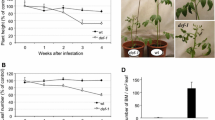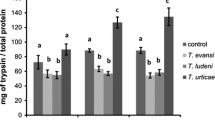Abstract
The Kanzawa spider mite, Tetranychus kanzawai, is a polyphagous herbivore that feeds on various plant families, including the Leguminacae. Scars made by the mite on lima bean leaves (Phaseolus lunatus) were classified into two types: white and red. We obtained two strains of mites—“White” and “Red”—by selecting individual mites based on the color of the scars. Damage made by the Red strain induced the expression of genes for both basic chitinase, which was downstream of the jasmonic acid (JA) signaling pathway, and acidic chitinase, which was downstream of the salicylic acid (SA) signaling pathway. White strain mites also induced the expression of the basic chitinase gene in infested leaves but they only slightly induced the acidic chitinase gene. The Red genotype was dominant over the White for the induction of the acidic chitinase gene. The amount of endogenous salicylates in leaves increased significantly when infested by Red strain mites but did not increase when infested by White strain mites. JA and SA are known to be involved in the production of lima bean leaf volatiles induced by T. urticae. The blend of volatiles emitted from leaves infested by the Red strain were qualitatively different from those infested by the White strain, suggesting that the SA and JA signaling pathways are differently involved in the production of lima bean leaf volatiles induced by T. kanzawai of different strains.






Similar content being viewed by others

References
Arimura, G., Ozawa, R., Shimoda, T., Nishioka, T., Boland, W., and Takabayashi, J. 2000. Herbivory-induced volatiles elicit defence genes in lima bean leaves. Nature 406:512–515.
Boland, W., Hopke, J., Donath, J., Nüske, J., and Bublitz, F. 1995. Jasmonic acid and coronatin induce odor production in plants. Angew. Chem. Int. Ed. Engl. 34:1600–1602.
Creelman, R. A. and Mullet, J. E. 1997. Biosynthesis and action of jasmonates in plants. Annu. Rev. Plant Physiol. Plant Mol. Biol. 48:355–381.
De Moraes, C. M., Lewis, W. J., Pare, P. W. Alborn, H. T., and Tumlinson, J. H. 1998. Herbivore-induced plants selectively attract parasitoids. Nature 393:570–573.
Dicke, M. 1994. Local and systemic production of volatile herbivore-induced terpenoids—their role in plant–carnivore mutualism. J. Plant Physiol. 143:465–472.
Dicke, M. 2000. Chemical ecology of host-plant selection by herbivorous arthropods: A multitrophic perspective. Biochem. Syst. Ecol. 28:601–617.
Dicke, M., Gols, R., Ludeking, D., and Posthumus, M. A. 1999. Jasmonic acid and herbivory differentially induce carnivore-attracting plant volatiles in lima bean plants. J. Chem. Ecol. 25:1907–1922.
Dicke, M. and Vet, L. E. M. 1999. Plant–carnivore interactions: Evolutionary and ecological consequences for plant, herbivore and carnivore, pp. 483–520, in H. Olff, V. K. Brown, and R. H. Drent (eds.). Herbivores: Between Plants and Predators. Blackwell Science, Oxford.
Durner, J., Shah, J., and Klessig, D. F. 1997. Salicylic acid and disease resistance in plants. Trends Plant Sci. 2:266–274.
Gols, R., Posthumus, M. A., and Dicke, M. 1999. Jasmonic acid induces the production of gerbera volatiles that attract the biological control agent Phytoseiulus persimilis. Entomol. Exp. Appl. 93:77–86.
Gomi, K. and Gotoh, T. 1996. Host plant preference and genetic compatibility of the Kanzawa spider mite, Tetranychus kanzawai Kishida (Acari: Tetranychidae). Appl. Entomol. Zool. 31:417–425.
Hopke, J., Donath, J., Blechert, S., and Boland, W. 1994. Herbivore-induced volatiles: the emission of acyclic homoterpenes from leaves of Phaseolus lunatus and Zea mays can be triggered by a β-glucosidase and jasmonic acid. FEBS Lett. 352:146–150.
Kessler, A. and Baldwin, I. T. 2002. Plant responses to insect herbivory: The emerging molecular analysis. Annu. Rev. Plant Biol. 53:299–328.
Koch, T., Krumm, T., Jung, V., Engelberth, J., and Boland, W. 1999. Differential induction of plant volatile biosynthesis in the lima bean by early and late intermediates of the octadecanoid-signaling pathway. Plant Physiol. 121:153–162.
Koiwa, H., Bressan, R. A., and Hasegawa, P. M. 1997. Regulation of protease inhibitors and plant defense. Trends Plant Sci. 2:379–384.
Malamy, J., Hennig, J., and Klessig, D. F. 1992. Temperature-dependent induction of salicylic acid and its conjugates during the resistance response to tobacco mosaic virus infection. Plant Cell 4:359–366.
Ozawa, R., Arimura, G., Takabayashi, J., Shimoda, T., and Nishioka, T. 2000. Involvement of jasmonate- and salicylate-related signaling pathways for the production of specific herbivore-induced volatiles in plants. Plant Cell Physiol. 41:391–398.
Ozawa, R., Shiojiri, K., Sabelis, M. W., Arimura, G., Nishioka, T., and Takabayashi, J. 2004. Corn plants treated with jasmonic acid attract more specialist parasitoids, thereby increasing parasitisation of the common armyworm. J. Chem. Ecol. 30:1797–1808.
Ryals, J. A., Neuenschwander, U. H., Willits, M. G., Molina, A., Steiner H.-Y., and Hunt, M. D. 1996. Systemic acquired resistance. Plant Cell 8:1809–1819.
Sabelis, M. W., Afman, B. P., and Slim, P. J. 1984. Location of distant spider-mite colonies by Phytoseiulus persimilis: Localization and extraction of a kairomone, pp. 431–440, in D. A. Griffiths and C. E. Bowman (eds.). Acarology VI. Vol. 1. Halsted Press, New York.
Schmelz, E. A., Alborn, H. T., Banchio, E., and Tumlinson, J. H. 2003. Quantitative relationships between induced jasmonic acid levels and volatile emission in Zea mays during Spodoptera exigua herbivory. Planta 216:665–673.
Takabayashi, J. and Dicke, M. 1996. Plant–carnivore mutualism through herbivore-induced carnivore attractants. Trends Plant Sci. 1:109–113.
Thomma, B. P. H. J., Eggermont, K., Penninckx, I. A. M. A., Mauch-Mani, B., Vogelsang, R., Cammue, B. P. A., and Broekaert, W. F. 1998. Separate jasmonate-dependent and salicylate-dependent defense-response pathways in Arabidopsis are essential for resistance to distinct microbial pathogens. Proc. Natl. Acad. Sci. U.S.A. 95:15107–15111.
Wasternack, C. and Parthier, B. 1997. Jasmonate-signalled plant gene expression. Trends Plant Sci. 2:302–307.
Yano, S., Kanaya, M., and Takafuji, A. 2003. Genetic basis of color variation in leaf scars induced by the Kanzawa spider mite. Entomol. Exp. Appl. 106:37–44.
Acknowledgments
We thank Syuichi Yano for the helpful discussion to RM. This study was supported by CREST of JST (Japan Science and Technology Corporation) and by a postdoctoral fellowship to R.M. from Japan Society for the Promotion of Science (16000439-00).
Author information
Authors and Affiliations
Corresponding author
Additional information
Ryo Matsushima and Rika Ozawa contributed equally to this work.
Rights and permissions
About this article
Cite this article
Matsushima, R., Ozawa, R., Uefune, M. et al. Intraspecies Variation in the Kanzawa Spider Mite Differentially Affects Induced Defensive Response in Lima Bean Plants. J Chem Ecol 32, 2501–2512 (2006). https://doi.org/10.1007/s10886-006-9159-z
Published:
Issue Date:
DOI: https://doi.org/10.1007/s10886-006-9159-z



